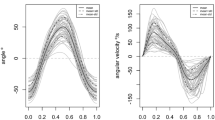Abstract
We measured maximum isometric neck strength under combinations of flexion/extension, lateral bending and axial rotation to determine whether neck strength in three dimensions (3D) can be predicted from principal axes strength. This would allow biomechanical modelers to validate their neck models across many directions using only principal axis strength data. Maximum isometric neck moments were measured in 9 male volunteers (29 ± 9 years) for 17 directions. The 3D moments were normalized by the principal axis moments, and compared to unity for all directions tested. Finally, each subject’s maximum principal axis moments were used to predict their resultant moment in the off-axis directions. Maximum moments were 30 ± 6 N m in flexion, 32 ± 9 N m in lateral bending, 51 ± 11 N m in extension, and 13 ± 5 N m in axial rotation. The normalized 3D moments were not significantly different from unity (95% confidence interval contained one), except for three directions that combined ipsilateral axial rotation and lateral bending; in these directions the normalized moments exceeded one. Predicted resultant moments compared well to the actual measured values (r 2 = 0.88). Despite exceeding unity, the normalized moments were consistent across subjects to allow prediction of maximum 3D neck strength using principal axes neck strength.



Similar content being viewed by others
References
Cagnie, B., A. Cools, V. De Loose, D. Cambier, and L. Danneels. Differences in isometric neck muscle strength between healthy controls and women with chronic neck pain: the use of a reliable measurement. Arch. Phys. Med. Rehabil. 88(11):1441–1445, 2007.
Gabriel, D. A., J. Y. Matsumoto, D. H. Davis, B. L. Currier, and K.-N. An. Multidirectional neck strength and electromyographic activity for normal controls. Clin. Biomech. 19(7):653–658, 2004.
Jordan, A., J. Mehlsen, P. M. Bülow, K. Ostergaard, and B. Danneskiold-Samsøe. Maximal isometric strength of the cervical musculature in 100 healthy volunteers. Spine 24(13):1343–1348, 1999.
Kumar, S., Y. Narayan, and T. Amell. Cervical strength of young adults in sagittal, coronal, and intermediate planes. Clin. Biomech. 16(5):380–388, 2001.
Mayoux-Benhamou, M. A., M. Wybier, and M. Revel. Strength and cross-sectional area of the dorsal neck muscles. Ergonomics 32(5):513–518, 1989.
Portero, P., A. X. Bigard, D. Gamet, J. R. Flageat, and C. Y. Guézennec. Effects of resistance training in humans on neck muscle performance, and electromyogram power spectrum changes. Eur. J. Appl. Physiol. 84(6):540–546, 2001.
Queisser, F., R. Blüthner, and H. Seidel. Control of positioning the cervical spine and its application to measuring extensor strength. Clin. Biomech. 9(3):157–161, 1994.
Vasavada, A. N., S. Li, and S. L. Delp. Influence of muscle morphometry and moment arms on the moment-generating capacity of human neck muscles. Spine 23(4):412–422, 1998.
Vasavada, A. N., S. Li, and S. L. Delp. Three-dimensional isometric strength of neck muscles in humans. Spine 26(17):1904–1909, 2001.
Ylinen, J., P. Salo, M. Nykänen, H. Kautiainen, and A. Häkkinen. Decreased isometric neck strength in women with chronic neck pain and the repeatability of neck strength measurements. Arch. Phys. Med. Rehabil. 85(8):1303–1308, 2004.
Acknowledgments
This work was funded by the generous support from the National Science and Engineering Research Council of Canada and the Canada Foundation for Innovation. JBF was supported by a CGS-D scholarship from the National Science and Engineering Research Council of Canada. JSB received salary support from the Michael Smith Foundation for Health Research and the Canadian Chiropractic Research Foundation. GPS received a salary and owned stock in MEA Forensic Engineers and Scientists.
Author information
Authors and Affiliations
Corresponding author
Additional information
Associate Editor Joel D. Stitzel oversaw the review of this article.
Electronic supplementary material
Below is the link to the electronic supplementary material.
Rights and permissions
About this article
Cite this article
Fice, J.B., Siegmund, G.P. & Blouin, JS. Prediction of Three Dimensional Maximum Isometric Neck Strength. Ann Biomed Eng 42, 1846–1852 (2014). https://doi.org/10.1007/s10439-014-1046-0
Received:
Accepted:
Published:
Issue Date:
DOI: https://doi.org/10.1007/s10439-014-1046-0




